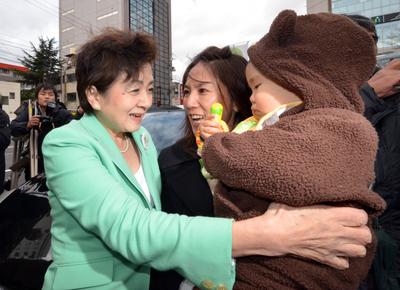This scenario is now changing fast, the short official election-campaign period having started on 4 December.
In the lead-up to the elections, political leaders are busy forming, re-forming, disbanding and merging political parties. Two new ‘third force’ political parties have emerged recently: the Japan Restoration Party and the Japan Future Party. These parties have been created to challenge the two established political parties, which many believe have been unable to address some of the most pressing social, political and economic issues facing Japan today. Some key issues concern whether Japan should join the Trans-Pacific Partnership negotiations, how to handle the nuclear issue in the wake of the Fukushima disaster and how best to use the increased consumption tax for Japan’s ageing society.
What is interesting is that both of the new ‘third force’ parties are driven by local political leaders, and some former LDP and DPJ heavyweights are joining these parties to push agendas different from those of the two major parties. Nippon Ishin no Kai (Japan Restoration Party) is led by the right-wing conservative former governor of Tokyo, Shintaro Ishihara, who disbanded his newly established Taiyo no To (Sunrise Party) to merge with the Japan Restoration Party. The latter was established by the mayor of Osaka City and former governor of Osaka Prefecture, Toru Hashimoto, a young, photogenic, media-savvy conservative politician.
Another ‘third force’ party, Nippon Mirai no To (Japan Future Party), was established by Shiga Prefecture governor Yukiko Kada. Her party’s main aim is to phase out nuclear power plants within 10 years and make Japan a nuclear-free country. In a bizarre recent development, the former LDP politician and founder of the DPJ, Ichiro Ozawa, who recently formed Kokumin no Seikatsu ga Daiichi (the People’s Life First Party) disbanded the party to merge with the Japan Future Party, and embraced the no-nuclear agenda. Nagoya mayor Takashi Kawamura and high-profile politician Shizuka Kamei, as well as three lower house members of the new Midori no Kaze (Green Wind), have also joined Kada’s party.
Minna no To (Your Party), formed in 2009 by former LDP politician Yoshimi Watanabe, has declared that the party will not join any of the new ‘third force’ parties and has already issued its election manifesto, ‘Agenda’, opposing nuclear power plants and consumption-tax increases.
In addition to these new ‘third force’ parties, there are some ‘old’ political parties such as the Komeito, the Social Democratic Party and the Japanese Communist Party that will also be running candidates, as they have done in the past.
The 2012 general elections seem to be changing from a primarily two-way race into a four-way contest between the LDP, DPJ, and the two new ‘third force’ parties. The rise of ‘third force’ parties is good news for Japanese democracy, as people have more political choice. But it also makes Japan’s politics messier and less stable than ever before. In the last six years, Japan has seen prime ministers changing on an almost annual basis. This has hardly served Japan’s interests nationally and internationally.
Furthermore, voters seem to be confused as to why so many parties are being formed and re-formed, and politicians are moving from one party to another, without any clear political message.
While many may flock to the Future Party, whose main agenda is to abandon nuclear power, the current state of political confusion seems to give a clear advantage to the LDP as the most well-known brand in Japanese politics. But whether under Shinzo Abe the party will make any difference to Japan’s politics and economy remains unknown.
Purnendra Jain is Professor at the University of Adelaide and Visiting Professor at the National Graduate Institute for Policy Studies, Tokyo.


RT @east_asia_forum: ‘Third force’ parties crowd Japan’s national political scene by Purnendra Jain http://t.co/dg4HLSwc
RT @east_asia_forum: ‘Third force’ parties crowd Japan’s national political scene by Purnendra Jain http://t.co/dg4HLSwc